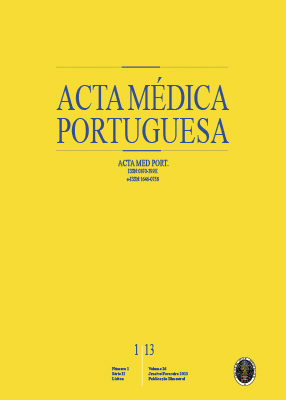The Primary Care Frequent Attender Profile
DOI:
https://doi.org/10.20344/amp.4007Abstract
Introduction: Frequent attenders are believed to represent a problem in Primary Care, with human, economic and social impact. The present study aimed to describe these patients’ sociodemographic and pathological characteristics. Material and Methods: A cross-sectional study with analytical component was conducted in the population of frequent attenders in a Portuguese Primary Health Care Practice, between January 2007 and December 2009, allocated to six General Practitioners. Sociodemographic characteristics as well as data related to physical and mental illness were collected from clinical records. Associations between variables were tested with χ-square and t-test. The top quartile of frequent attenders was compared with the remaining population. The adopted significance level was 0.05. Results: Of the 582 individuals evaluated, with a mean age of 55.4 years (men 58.6 and women 54.3; p = 0.006), 85% had chronic physical illness and 42% had chronic psychiatric illness. In the upper quartile of frequent attenders was observed a higher prevalence of chronic psychiatric illness (p < 0.001), as well as multiple pathology (p = 0.01), when compared to the remaining population. Individuals with physical illness were older (mean age: 58.0 years vs 40.1 years; p < 0.001) while those with chronic psychiatric illness were younger (mean age 53.7 years vs 56.6; p = 0.035). Discussion: It was drawn a profile of the frequent attender consistent with international literature, at a time when there are no studies in Portuguese Primary Care settings. Information and selection bias were detected and minimized. In order to discriminate between frequent attenders, the upper quartile was compared with the remaining population. Some features seemed to be more associated with frequent attendance, such as advanced age, low educational level and the presence of chronic psychiatric illness. Conclusion: The frequent attender of this Portuguese Primary Care Practice is a female, in the sixth decade of life, with low educational level, married or living as a couple, coming from a nuclear family, and often with chronic illness. Knowledge of these patients may allow the development of strategies that lead to more cost-effective health care services. This study shows some guidelines for studies on this important population.
Downloads
Downloads
Published
How to Cite
Issue
Section
License
All the articles published in the AMP are open access and comply with the requirements of funding agencies or academic institutions. The AMP is governed by the terms of the Creative Commons ‘Attribution – Non-Commercial Use - (CC-BY-NC)’ license, regarding the use by third parties.
It is the author’s responsibility to obtain approval for the reproduction of figures, tables, etc. from other publications.
Upon acceptance of an article for publication, the authors will be asked to complete the ICMJE “Copyright Liability and Copyright Sharing Statement “(http://www.actamedicaportuguesa.com/info/AMP-NormasPublicacao.pdf) and the “Declaration of Potential Conflicts of Interest” (http:// www.icmje.org/conflicts-of-interest). An e-mail will be sent to the corresponding author to acknowledge receipt of the manuscript.
After publication, the authors are authorised to make their articles available in repositories of their institutions of origin, as long as they always mention where they were published and according to the Creative Commons license.









